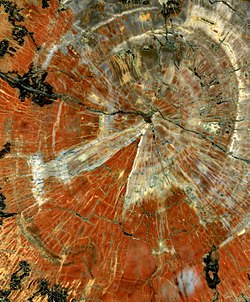
Back Malakonac a kilang AMI خشب متحجر Arabic Вкаменено дърво Bulgarian শিলীভূত কাঠ Bengali/Bangla Bosc petrificat Catalan Zkamenělé dřevo Czech Forstenet træ Danish Holzstein German Απολιθωμένο ξύλο Greek Bosque petrificado Spanish


Petrified wood, also known as petrified tree (from Ancient Greek πέτρα meaning 'rock' or 'stone'; literally 'wood turned into stone'), is the name given to a special type of fossilized wood, the fossilized remains of terrestrial vegetation. Petrifaction is the result of a tree or tree-like plants having been replaced by stone via a mineralization process that often includes permineralization and replacement.[1] The organic materials making up cell walls have been replicated with minerals (mostly silica in the form of opal, chalcedony, or quartz). In some instances, the original structure of the stem tissue may be partially retained. Unlike other plant fossils, which are typically impressions or compressions, petrified wood is a three-dimensional representation of the original organic material.
The petrifaction process occurs underground, when wood becomes buried in water or volcanic ash. The presence of water reduces the availability of oxygen which inhibits aerobic decomposition by bacteria and fungi. Mineral-laden water flowing through the sediments may lead to permineralization, which occurs when minerals precipitate out of solution filling the interiors of cells and other empty spaces. During replacement, the plant's cell walls act as a template for mineralization.[2] There needs to be a balance between the decay of cellulose and lignin and mineral templating for cellular detail to be preserved with fidelity. Most of the organic matter often decomposes, however some of the lignin may remain.[3] Silica in the form of opal-A, can encrust and permeate wood relatively quickly in hot spring environments.[4] However, petrified wood is most commonly associated with trees that were buried in fine grained sediments of deltas and floodplains or volcanic lahars and ash beds.[5][6] A forest where such material has petrified becomes known as a petrified forest.
- ^ Mustoe, George (2017-11-20). "Wood Petrifaction: A New View of Permineralization and Replacement". Geosciences. 7 (4): 17. Bibcode:2017Geosc...7..119M. doi:10.3390/geosciences7040119.
- ^ Leo, Richard; Barghoorn, Elso (1976-12-07). "Silicification of Wood". Botanical Museum Leaflets, Harvard University. 25 (1): 47. doi:10.5962/p.295209. JSTOR 41762773.
- ^ "Frequently Asked Questions - Petrified Forest National Park (U.S. National Park Service)".
- ^ Akahane, Hisatada; Furuno, Takeshi; Miyajima, Hiroshi; Yoshikawa, Toshiyuki; Yamamoto, Shigeru (2004-07-15). "Rapid wood silicification in hot spring water: An explanation of silicification of wood during the Earth's history". Sedimentary Geology. 169 (3–4): 219–228. Bibcode:2004SedG..169..219A. doi:10.1016/j.sedgeo.2004.06.003.
- ^ Muratal, Kiguma (1940-08-01). "Volcanic Ash as a Source of Silica for Silicification of Wood". American Journal of Science. 238 (8): 10. Bibcode:1940AmJS..238..586M. doi:10.2475/ajs.238.8.586. Archived from the original on 2019-10-10. Retrieved 2019-10-10.
- ^ Matysovà, Petral; Roßler, Ronny; Götz, Jens; Leichmann, Jaromír; Forbes, Gordon; Taylor, Edith; Sakala, Jakub; Grygar, Tomáš (2010-06-01). "Alluvial and Volcanic Pathways to Silicified Plant Stems (Upper Carboniferous-Triassic) and their Taphonomic and Paleoenvironmental Meaning". Palaeogeography, Palaeoclimate, Palaeoecology. 292 (1–2): 17. Bibcode:2010PPP...292..127M. doi:10.1016/j.palaeo.2010.03.036.
© MMXXIII Rich X Search. We shall prevail. All rights reserved. Rich X Search